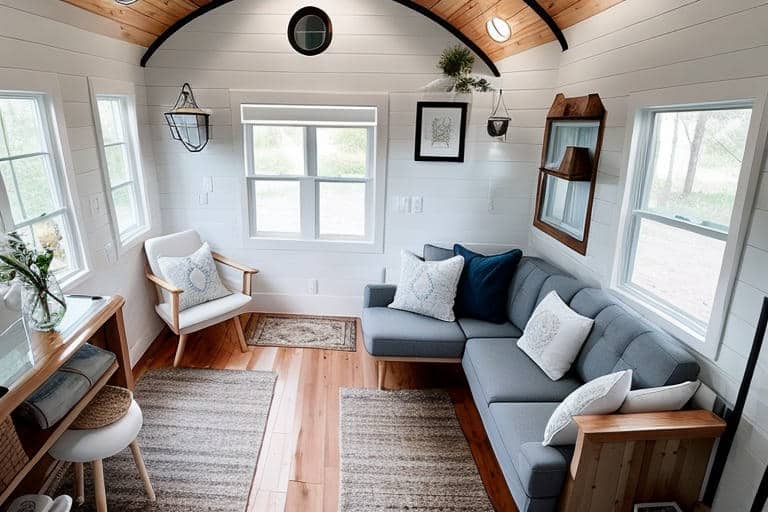Table of Contents
Introduction
Tiny homes are becoming increasingly popular among students and teaching staff due to their affordability, eco-friendliness and mobility. Tiny homes are typically under 400 square feet, making them an affordable option for people on a tight budget. They also promote a minimalist lifestyle which can reduce stress. However, they offer less space than traditional homes, making it difficult to find private space and to entertain guests. This article examines the pros and cons of tiny homes for students in detail.
Background on Tiny Homes
Tiny homes have been around for centuries in different forms, with some being used as temporary housing during wars or natural disasters. In recent years, tiny homes have become more popular due to their affordability and eco-friendliness. They are also highly mobile, making them ideal for those who need to move frequently.
Overview of Pros and Cons
The advantages of tiny homes include their cost-effectiveness, mobility, and stress-free living. On the other hand, they have several disadvantages such as limited space, lack of privacy, and difficulty in moving them. In this article, we will explore both the advantages and disadvantages of tiny homes for students in detail.
Advantages of Tiny Homes for Students
Tiny homes have become increasingly popular among students and teaching staff due to their affordability, eco-friendliness and mobility. There are many advantages to living in a tiny home, including cost-effectiveness, mobility and stress-free living.
Cost-Effective
The main advantage of tiny homes is that they are highly cost-effective. Since tiny homes are usually under 400 square feet, they are much cheaper to build and maintain than traditional homes. This makes them perfect for people on a tight budget, such as students or those with limited incomes. Additionally, since tiny homes require less energy to heat and cool, they also tend to have lower utility bills than traditional homes.
Highly Mobile
Another benefit of tiny homes is that they are highly mobile. Since they are small and lightweight, they can easily be moved from one location to another. This makes them ideal for people who need to move frequently or who want the freedom to explore different locations. Additionally, since tiny homes can usually be towed behind a car or truck, they don’t require a large vehicle to transport them.
Stress-Free Living
Tiny homes also promote a minimalist lifestyle which can reduce stress. Since there is less space available in a tiny home, it encourages people to prioritize the items that they need and get rid of the things that they don’t need. This can help reduce clutter and make it easier to keep the home organized. Additionally, living in a smaller space can also help people focus on what’s important in life and appreciate the simple things instead of getting caught up in material possessions.
Main Idea: Tiny homes are popular among students and teaching staff due to their affordability, eco-friendliness and mobility. Key Findings: Cost-effective, highly mobile, stress-free living.
Disadvantages of Tiny Homes for Students
Tiny homes are becoming increasingly popular among students and teaching staff due to their affordability, eco-friendliness, and mobility. However, there are also some disadvantages to these homes that should be taken into consideration.
Limited Space
One of the most significant drawbacks of tiny homes is the limited living space they offer. These homes are usually under 400 square feet, meaning that they have much less space than traditional homes. This can make it difficult to find private space and to entertain guests. With limited storage space, it can also be challenging to keep things organized and tidy.
Lack of Privacy
The lack of privacy is another disadvantage associated with tiny homes. Since there is less living space, it can be hard to find a place to escape from the hustle and bustle of everyday life. This can lead to feelings of isolation and loneliness for some people who live in these homes.
Difficult to Move
Finally, moving a tiny home can be difficult because of its size and weight. many tiny homes are built on trailers or wheels, which makes them easier to transport but still requires a lot of effort and planning to do so safely. Additionally, some states have laws that limit how far a tiny home can be moved without a permit or special licensing, making it even more difficult for people who want to relocate their home.
In conclusion, while tiny homes offer several advantages such as cost-effectiveness, mobility, and stress-free living, there are also some disadvantages associated with them such as limited space, lack of privacy, and difficulty in moving them from one location to another. It is important for potential buyers to consider all aspects before making a decision about whether or not a tiny home is right for them.
Tiny homes offer advantages but also have disadvantages such as limited space, lack of privacy, and difficulty in moving.
Conclusion
Summary of Pros and Cons
Tiny homes offer a unique living experience for students and teaching staff alike. On the one hand, they are cost-effective, highly mobile and promote a stress-free lifestyle. On the other hand, they lack space, privacy and can be difficult to move.
Final Thoughts on Tiny Homes for Students
Despite their drawbacks, tiny homes are becoming increasingly popular among students and teaching staff due to their affordability, eco-friendliness and mobility. For those looking for an alternative to traditional housing solutions, tiny homes provide an attractive option that may be worth considering.
Ultimately, it is up to each individual to decide if a tiny home is the right choice for them. It is important to weigh the pros and cons carefully before making a decision so that you can make an informed choice that best suits your needs and lifestyle.


